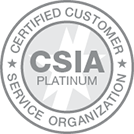Maximize the online experience for attendees
Social media is an integral part of our lives. Whether in line at the grocery store, killing time on a train, or in the break room at work, we want to stay connected.
Social media has evolved into a necessity for non-profit marketing. What does this mean when planning experiences for conferences and meetings? Social media needs to be laced throughout programming and events.
Executing a well-received and engaging conference or meeting requires a successful social media strategy. Here is some practical advice for planning, publicizing, and executing a successful on-site social media strategy.
Evaluate Your Audience's Social Media Preferences
Depending on the members that make up your non-profit, determine what the most effective social media channels are to reach event attendees.
Are attendees big on Facebook? Then plan to develop a content strategy that is more discussion or visual-based. Are attendees a Twitter crowd? Plan to host live-tweeting sessions. “You may decide to post once or twice a day on Facebook and LinkedIn, and multiple times throughout the day on your Instagram story and on Twitter,” said Kira Jones, marketing account manager. Once the social media outlet is confirmed, research the biggest advocates on that network.
Publicize Event Social Media Early and Often
Start thinking about the social media experience for your conference as soon as you start planning it for the next year. You may choose to use hashtags to distinguish your meeting on social networks and to make posts easily searchable.
Decide on a hashtag as early in the process as possible and make sure all those involved in planning know about it. “Hashtags are a great way to monitor conversations about your event, engage with attendees, and for prospective attendees to quickly get a sense for what they can expect at your meeting,” Jones said. Include hashtags on all promotional materials or emails so they stay in the heads of attendees. Use them in social media messaging leading up to the event or send out a few emails prior to let attendees know to use them when posting on-site.
Determine On-Site Social Media Responsibilities Before the Event
Before you even arrive on-site, determine who will be doing what with regard to social media. Is one team member better with Twitter? Assign them to live-tweet sessions. Is someone a better photographer? Have them handle photo-sharing channels like Instagram or Facebook. Is one team member there as a jack-of-all-trades? Have them Instagram's integration feature that allows simultaneous posting to other social platforms such as Facebook and Twitter.
“There are countless ways to delegate social media responsibilities, and it really depends on how many platforms your organization has, how active you want to be on them, and how comfortable your staff is using social media,” Jones said. Regardless of the approach, it is critical to have someone monitoring all platforms and responding to comments or questions throughout the event.
And that understanding of delegation becomes paramount during the event. “Delegation is especially important to consider when you have concurrent sessions because a person can only be in one place at a time. So, if you want to post about two concurrent sessions, you'll need at least two people to capture the content,” Jones said. The best approach to concurrent sessions is to make sure that responsibilities are clear, and expectations are defined.
Set Up A Conference Social Media Dashboard
When on-site, it can be useful to set up a dashboard that displays all social media channels and posts on a single screen. A good way to do this is to sign up with Hootsuite, a social media management application. Once you have it set up, create a "stream" that features your event's Twitter feeds, hashtags, mentions of your account, and any retweets. You can also use it to view Facebook posts, as well as a number of other social media platforms.
This is a great way to set up a "home base" while you're on-site and to monitor social activity and conversations from your event attendees.
Publicize Social Media Throughout the Event and Encourage Participation
The best-laid plans and organized social media strategy will struggle if no one knows about it. Solve this problem by publicizing any social media channels you’re using in event handouts, on signs around the conference venue, and during opening sessions. Further, ask presenters to include relevant hashtags and their Twitter handles at the bottom of presentation slides. The goal is to get the word out through as many avenues as possible.
And getting the word out means interacting with your audience. “For example, when people comment on your posts, be sure to like their comments and when they share your posts, thank them. Ask questions like ‘Which sessions are you most looking forward to at this year's annual meeting?’ or share polls to encourage participation,” Jones said. A simple and cost-effective way to drive more social media engagement could be by running a contest. Winners can be drawn from those who tweet using the conference hashtag.




